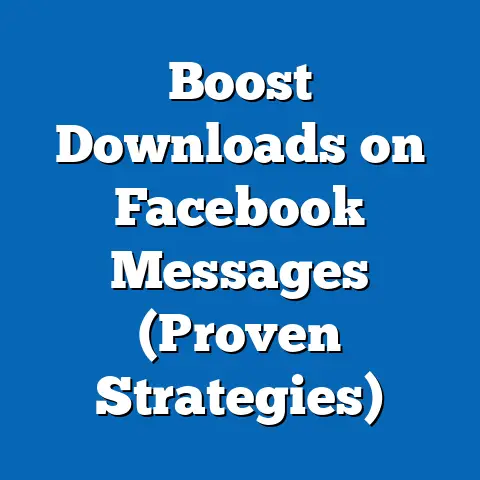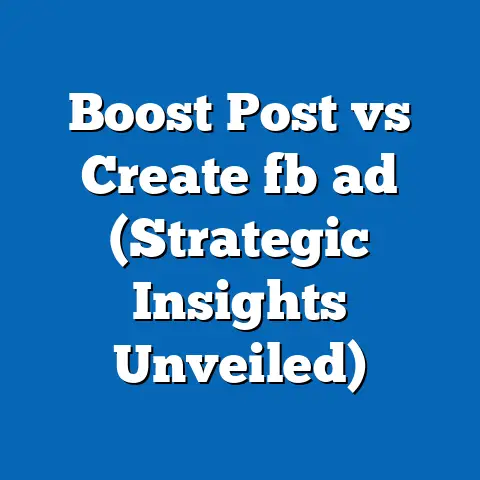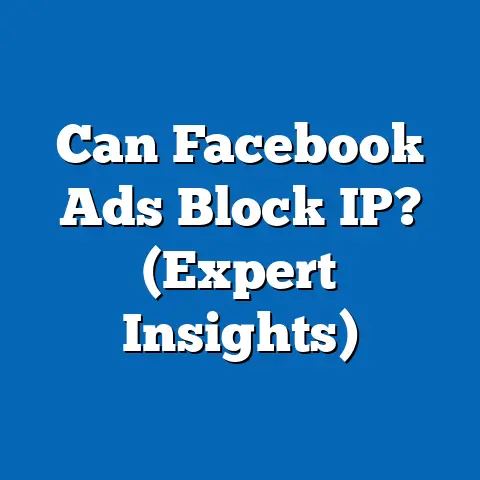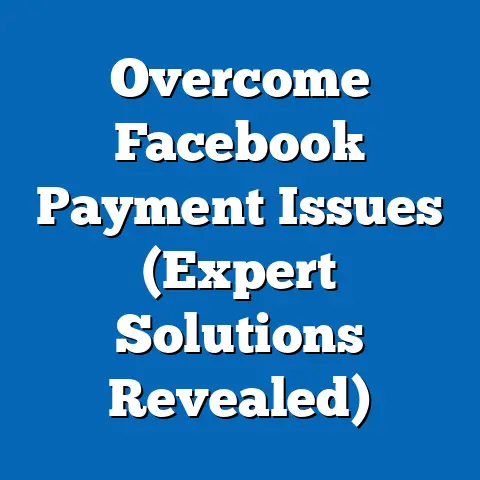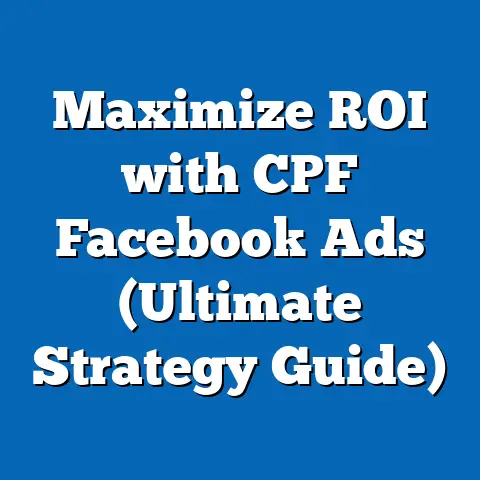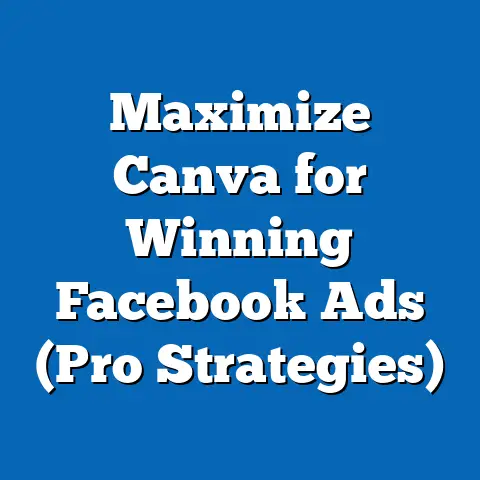Unlock Facebook Ads Secrets for 2025 (Proven Strategies)
Facebook advertising has become an indispensable tool for businesses and marketers aiming to amplify their online presence. What I love most about Facebook Ads is how accessible they are. You don’t need a massive marketing budget or a team of experts to get started. With a little know-how, anyone can create and launch campaigns that reach their target audience effectively. It’s like having a direct line to millions of potential customers, right at your fingertips.
Understanding the Evolution of Facebook Ads
To truly understand where Facebook Ads are going, it’s essential to look back at where they’ve been. I remember when Facebook Ads were just simple sidebar ads with a small image and a few lines of text. They were effective in their own way, but they lacked the sophistication and targeting capabilities we see today.
Key Milestones in Facebook Ad History
-
The Introduction of News Feed Ads (2007): This was a game-changer. Ads started appearing directly in users’ News Feeds, making them more engaging and less intrusive.
-
The Acquisition of Instagram (2012): Expanding the ad network to Instagram broadened reach and opened up new creative possibilities, especially with visual content.
-
The Launch of Power Editor (2013): This gave advanced users more control over their campaigns, allowing for granular targeting and optimization.
-
The Pixel and Conversion Tracking (2015): The Facebook Pixel revolutionized ad tracking, allowing businesses to measure the ROI of their campaigns and optimize for conversions.
-
The Rise of Video Ads (2016-Present): With the increasing popularity of video content, Facebook Ads evolved to include more video-centric formats, like live videos and 360 videos.
The Introduction of News Feed Ads (2007): This was a game-changer. Ads started appearing directly in users’ News Feeds, making them more engaging and less intrusive.
The Acquisition of Instagram (2012): Expanding the ad network to Instagram broadened reach and opened up new creative possibilities, especially with visual content.
The Launch of Power Editor (2013): This gave advanced users more control over their campaigns, allowing for granular targeting and optimization.
The Pixel and Conversion Tracking (2015): The Facebook Pixel revolutionized ad tracking, allowing businesses to measure the ROI of their campaigns and optimize for conversions.
The Rise of Video Ads (2016-Present): With the increasing popularity of video content, Facebook Ads evolved to include more video-centric formats, like live videos and 360 videos.
Adapting to the Changing Digital Landscape
Facebook hasn’t just sat back and watched the digital landscape evolve; it’s been an active participant in shaping it. As consumer behavior shifted towards mobile, Facebook Ads adapted with mobile-first ad formats and targeting options. When data privacy became a major concern, Facebook introduced features like Limited Data Use (LDU) and Aggregated Event Measurement (AEM) to comply with regulations while still delivering effective ads.
The Impact of Facebook Ads: Statistics and Data
- In 2023, Facebook’s advertising revenue reached over \$116 billion, showcasing its continued dominance in the digital advertising space. (Source: Statista)
- Approximately 93% of marketers use Facebook for advertising, highlighting its importance in marketing strategies. (Source: Social Media Examiner)
- Facebook ads have an average click-through rate (CTR) of 0.9%, which can be significantly higher depending on the industry and targeting. (Source: WordStream)
Takeaway: Understanding the history of Facebook Ads helps you appreciate the platform’s evolution and anticipate future changes. By recognizing key milestones and adapting to consumer behavior, you can leverage the platform’s capabilities to achieve your marketing goals.
The Importance of Audience Targeting in 2025
If there’s one thing I’ve learned over the years, it’s that audience targeting is the backbone of any successful Facebook Ads campaign. It’s not enough to have a great product or service; you need to get it in front of the right people. In 2025, audience targeting will be more sophisticated than ever before, thanks to advancements in data analysis and machine learning.
The Evolution of Audience Targeting
In the early days, Facebook Ads targeting was fairly basic. You could target users based on age, gender, location, and a few broad interests. But as the platform evolved, so did its targeting capabilities. Today, you can target users based on a wide range of criteria, including:
- Demographics: Age, gender, education, relationship status, job title, and more.
- Interests: Hobbies, passions, and topics they engage with on Facebook.
- Behaviors: Purchase history, device usage, travel habits, and other online activities.
- Connections: People who like your page, friends of people who like your page, or people who have interacted with your content.
Advanced Targeting Options in 2025
-
Lookalike Audiences: This is one of my favorite targeting options. You can upload a list of your best customers, and Facebook will find users who share similar characteristics and behaviors. This is a great way to expand your reach and find new customers who are likely to be interested in your products or services.
-
Custom Audiences: Custom Audiences allow you to target users based on your own data sources, such as email lists, website visitors, or app users. This is incredibly powerful because you’re targeting people who have already shown an interest in your business.
-
Interest-Based Targeting: This option allows you to target users based on their interests and hobbies. The key is to be specific and relevant. For example, if you’re selling fitness equipment, you might target users who are interested in running, weightlifting, or yoga.
Lookalike Audiences: This is one of my favorite targeting options. You can upload a list of your best customers, and Facebook will find users who share similar characteristics and behaviors. This is a great way to expand your reach and find new customers who are likely to be interested in your products or services.
Custom Audiences: Custom Audiences allow you to target users based on your own data sources, such as email lists, website visitors, or app users. This is incredibly powerful because you’re targeting people who have already shown an interest in your business.
Interest-Based Targeting: This option allows you to target users based on their interests and hobbies. The key is to be specific and relevant. For example, if you’re selling fitness equipment, you might target users who are interested in running, weightlifting, or yoga.
Tips for Refining Ad Targeting
-
Use Audience Insights: Facebook Audience Insights provides valuable data about your target audience, including their demographics, interests, and behaviors. Use this data to refine your targeting and create more relevant ads.
-
Test Different Audiences: Don’t be afraid to experiment with different targeting options. Create multiple ad sets with different audiences and see which ones perform best.
-
Monitor Your Results: Keep a close eye on your ad performance and make adjustments as needed. If an audience isn’t performing well, try refining your targeting or switching to a different audience altogether.
Use Audience Insights: Facebook Audience Insights provides valuable data about your target audience, including their demographics, interests, and behaviors. Use this data to refine your targeting and create more relevant ads.
Test Different Audiences: Don’t be afraid to experiment with different targeting options. Create multiple ad sets with different audiences and see which ones perform best.
Monitor Your Results: Keep a close eye on your ad performance and make adjustments as needed. If an audience isn’t performing well, try refining your targeting or switching to a different audience altogether.
Takeaway: Audience targeting is the key to reaching the right people with your Facebook Ads. By leveraging advanced targeting options and continuously refining your approach, you can maximize your ROI and achieve your marketing goals.
Creative Ad Formats to Leverage
In the ever-evolving world of Facebook advertising, creative ad formats are your secret weapon for capturing attention and driving engagement. I’ve seen firsthand how the right ad format can make all the difference in campaign performance. As we move towards 2025, it’s essential to explore and leverage the diverse range of ad formats that Facebook offers.
Exploring the Ad Format Landscape
-
Image Ads: These are the classic, straightforward ads featuring a single image with accompanying text. They’re simple to create and can be highly effective when paired with compelling visuals and concise copy.
-
Video Ads: Video ads are incredibly engaging and versatile. They allow you to tell a story, showcase your product in action, or deliver valuable information in a dynamic format.
-
Carousel Ads: Carousel ads display multiple images or videos in a scrollable format. This is perfect for showcasing a range of products, highlighting different features, or telling a sequential story.
-
Slideshow Ads: Slideshow ads combine multiple images or videos into a visually appealing slideshow. They’re a great alternative to video ads when you have limited resources or want to create a more lightweight ad experience.
Image Ads: These are the classic, straightforward ads featuring a single image with accompanying text. They’re simple to create and can be highly effective when paired with compelling visuals and concise copy.
Video Ads: Video ads are incredibly engaging and versatile. They allow you to tell a story, showcase your product in action, or deliver valuable information in a dynamic format.
Carousel Ads: Carousel ads display multiple images or videos in a scrollable format. This is perfect for showcasing a range of products, highlighting different features, or telling a sequential story.
Slideshow Ads: Slideshow ads combine multiple images or videos into a visually appealing slideshow. They’re a great alternative to video ads when you have limited resources or want to create a more lightweight ad experience.
Immersive Formats: Reels and Stories in 2025
As we approach 2025, immersive formats like Reels and Stories will continue to dominate the Facebook advertising landscape. These formats offer a more engaging and authentic ad experience, allowing you to connect with your audience on a deeper level.
-
Reels: Reels are short-form video ads that appear in the Reels feed. They’re perfect for capturing attention with creative and entertaining content.
-
Stories: Stories ads are full-screen ads that appear between users’ Stories. They’re ideal for showcasing your brand personality, promoting limited-time offers, or driving immediate action.
Reels: Reels are short-form video ads that appear in the Reels feed. They’re perfect for capturing attention with creative and entertaining content.
Stories: Stories ads are full-screen ads that appear between users’ Stories. They’re ideal for showcasing your brand personality, promoting limited-time offers, or driving immediate action.
Successful Campaigns: Real-World Examples
-
Nike: Nike has consistently leveraged video ads to inspire and motivate their audience. Their “Dream Crazy” campaign, featuring Colin Kaepernick, generated over \$43 million in earned media value and sparked a global conversation.
-
Airbnb: Airbnb has used carousel ads to showcase a variety of unique properties and travel experiences. This allows potential customers to explore different options and find the perfect fit for their needs.
-
GoPro: GoPro has mastered the art of user-generated content by featuring stunning videos and photos taken by their customers. This not only showcases the capabilities of their products but also builds a strong sense of community.
Nike: Nike has consistently leveraged video ads to inspire and motivate their audience. Their “Dream Crazy” campaign, featuring Colin Kaepernick, generated over \$43 million in earned media value and sparked a global conversation.
Airbnb: Airbnb has used carousel ads to showcase a variety of unique properties and travel experiences. This allows potential customers to explore different options and find the perfect fit for their needs.
GoPro: GoPro has mastered the art of user-generated content by featuring stunning videos and photos taken by their customers. This not only showcases the capabilities of their products but also builds a strong sense of community.
Takeaway: Creative ad formats are your key to capturing attention and driving engagement on Facebook. By exploring different formats and experimenting with immersive experiences, you can create campaigns that resonate with your target audience and achieve remarkable results.
Crafting Compelling Ad Copy and Visuals
In the realm of Facebook Ads, compelling ad copy and visuals are your dynamic duo for capturing attention and driving action. I’ve witnessed firsthand how the right combination of words and images can transform a mediocre ad into a high-performing masterpiece. As we journey towards 2025, mastering the art of crafting persuasive ad copy and eye-catching visuals will be more crucial than ever.
The Power of Persuasive Ad Copy
-
Know Your Audience: Before you start writing, take the time to understand your target audience. What are their pain points, desires, and motivations? Use this knowledge to craft ad copy that speaks directly to their needs.
-
Highlight Benefits, Not Features: Focus on the benefits your product or service provides, rather than just listing its features. How will it make their lives easier, better, or more enjoyable?
-
Use Emotional Triggers: Tap into your audience’s emotions by using words and phrases that evoke feelings of excitement, curiosity, or urgency.
-
Include a Clear Call-to-Action: Tell your audience exactly what you want them to do next. Use strong action verbs like “Shop Now,” “Learn More,” or “Get Started.”
Know Your Audience: Before you start writing, take the time to understand your target audience. What are their pain points, desires, and motivations? Use this knowledge to craft ad copy that speaks directly to their needs.
Highlight Benefits, Not Features: Focus on the benefits your product or service provides, rather than just listing its features. How will it make their lives easier, better, or more enjoyable?
Use Emotional Triggers: Tap into your audience’s emotions by using words and phrases that evoke feelings of excitement, curiosity, or urgency.
Include a Clear Call-to-Action: Tell your audience exactly what you want them to do next. Use strong action verbs like “Shop Now,” “Learn More,” or “Get Started.”
Eye-Catching Visuals: Tips and Tricks
-
Use High-Quality Images and Videos: Your visuals should be crisp, clear, and visually appealing. Avoid using blurry or pixelated images.
-
Align with Brand Messaging: Your visuals should be consistent with your brand identity and messaging. Use your brand colors, fonts, and style to create a cohesive look and feel.
-
Showcase Your Product in Action: If you’re selling a product, show it being used in a real-world setting. This helps potential customers visualize themselves using the product and experiencing its benefits.
-
Use Visual Hierarchy: Guide the viewer’s eye through your ad by using visual hierarchy. Use larger fonts for headlines and smaller fonts for body text. Use contrasting colors to draw attention to key elements.
Use High-Quality Images and Videos: Your visuals should be crisp, clear, and visually appealing. Avoid using blurry or pixelated images.
Align with Brand Messaging: Your visuals should be consistent with your brand identity and messaging. Use your brand colors, fonts, and style to create a cohesive look and feel.
Showcase Your Product in Action: If you’re selling a product, show it being used in a real-world setting. This helps potential customers visualize themselves using the product and experiencing its benefits.
Use Visual Hierarchy: Guide the viewer’s eye through your ad by using visual hierarchy. Use larger fonts for headlines and smaller fonts for body text. Use contrasting colors to draw attention to key elements.
Successful Campaigns: Real-World Examples
-
Dollar Shave Club: Dollar Shave Club’s viral video ad is a perfect example of how humor and wit can capture attention and drive sales. The ad was low-budget but highly creative, and it resonated with their target audience.
-
Old Spice: Old Spice’s “The Man Your Man Could Smell Like” campaign is another example of how humor and personality can make a brand stand out. The ads were funny, memorable, and highly effective in driving sales.
-
Apple: Apple’s product ads are known for their simplicity and elegance. They focus on showcasing the product’s design and features in a visually appealing way.
Dollar Shave Club: Dollar Shave Club’s viral video ad is a perfect example of how humor and wit can capture attention and drive sales. The ad was low-budget but highly creative, and it resonated with their target audience.
Old Spice: Old Spice’s “The Man Your Man Could Smell Like” campaign is another example of how humor and personality can make a brand stand out. The ads were funny, memorable, and highly effective in driving sales.
Apple: Apple’s product ads are known for their simplicity and elegance. They focus on showcasing the product’s design and features in a visually appealing way.
Takeaway: Compelling ad copy and visuals are essential for capturing attention and driving action on Facebook. By understanding your audience, highlighting benefits, using emotional triggers, and creating eye-catching visuals, you can create ads that resonate with your target audience and achieve remarkable results.
Leveraging the Power of Facebook Analytics
In the realm of Facebook advertising, data is your compass and analytics are your map. I’ve learned that without a deep understanding of your ad performance, you’re essentially flying blind. As we approach 2025, leveraging the power of Facebook Analytics will be more critical than ever for optimizing your campaigns and maximizing your ROI.
The Role of Facebook Analytics
Facebook Analytics is a powerful tool that provides valuable insights into your ad performance. It allows you to track key metrics, measure your results, and make data-driven decisions to improve your campaigns.
Key Metrics to Monitor
-
Click-Through Rate (CTR): This metric measures the percentage of people who click on your ad after seeing it. A high CTR indicates that your ad is relevant and engaging to your target audience.
-
Conversion Rate: This metric measures the percentage of people who take a desired action after clicking on your ad, such as making a purchase, filling out a form, or downloading an app. A high conversion rate indicates that your ad is effective in driving conversions.
-
Cost Per Click (CPC): This metric measures the average cost you pay each time someone clicks on your ad. A low CPC indicates that your ad is efficient in driving traffic.
-
Return on Ad Spend (ROAS): This metric measures the amount of revenue you generate for every dollar you spend on advertising. A high ROAS indicates that your ad campaign is profitable.
Click-Through Rate (CTR): This metric measures the percentage of people who click on your ad after seeing it. A high CTR indicates that your ad is relevant and engaging to your target audience.
Conversion Rate: This metric measures the percentage of people who take a desired action after clicking on your ad, such as making a purchase, filling out a form, or downloading an app. A high conversion rate indicates that your ad is effective in driving conversions.
Cost Per Click (CPC): This metric measures the average cost you pay each time someone clicks on your ad. A low CPC indicates that your ad is efficient in driving traffic.
Return on Ad Spend (ROAS): This metric measures the amount of revenue you generate for every dollar you spend on advertising. A high ROAS indicates that your ad campaign is profitable.
Actionable Insights: Using Data to Make Decisions
-
Identify High-Performing Ads: Use Facebook Analytics to identify your best-performing ads. Analyze what makes them successful and replicate those elements in your other campaigns.
-
Optimize Underperforming Ads: If an ad isn’t performing well, use Facebook Analytics to identify the problem. Is the CTR low? Is the conversion rate low? Make adjustments to your targeting, ad copy, or visuals to improve performance.
-
Refine Your Targeting: Use Facebook Analytics to understand which audiences are responding best to your ads. Refine your targeting to focus on those audiences and exclude those that aren’t performing well.
-
Test Different Ad Formats: Use Facebook Analytics to compare the performance of different ad formats. See which formats are driving the most engagement and conversions, and focus on those formats in your future campaigns.
Identify High-Performing Ads: Use Facebook Analytics to identify your best-performing ads. Analyze what makes them successful and replicate those elements in your other campaigns.
Optimize Underperforming Ads: If an ad isn’t performing well, use Facebook Analytics to identify the problem. Is the CTR low? Is the conversion rate low? Make adjustments to your targeting, ad copy, or visuals to improve performance.
Refine Your Targeting: Use Facebook Analytics to understand which audiences are responding best to your ads. Refine your targeting to focus on those audiences and exclude those that aren’t performing well.
Test Different Ad Formats: Use Facebook Analytics to compare the performance of different ad formats. See which formats are driving the most engagement and conversions, and focus on those formats in your future campaigns.
Takeaway: Facebook Analytics is your secret weapon for optimizing your ad campaigns and maximizing your ROI. By tracking key metrics, analyzing your results, and making data-driven decisions, you can create campaigns that resonate with your target audience and achieve remarkable results.
Future Trends in Facebook Advertising
As we look ahead to 2025, the future of Facebook advertising is filled with exciting possibilities and transformative technologies. I’ve been closely following these emerging trends, and I believe they will fundamentally reshape the way we approach advertising on the platform. Staying adaptable and open-minded is crucial for marketers who want to stay ahead of the curve.
Emerging Trends and Technologies
-
Artificial Intelligence (AI): AI is already playing a significant role in Facebook advertising, and its influence will only grow in the coming years. AI-powered tools can help you automate tasks, optimize your campaigns, and personalize your ads for individual users.
-
Augmented Reality (AR): AR offers immersive and interactive ad experiences that allow users to try on products virtually, explore virtual environments, and engage with brands in new and exciting ways.
-
Personalization: Personalization will become even more sophisticated in 2025, with ads being tailored to individual users based on their interests, behaviors, and preferences.
Artificial Intelligence (AI): AI is already playing a significant role in Facebook advertising, and its influence will only grow in the coming years. AI-powered tools can help you automate tasks, optimize your campaigns, and personalize your ads for individual users.
Augmented Reality (AR): AR offers immersive and interactive ad experiences that allow users to try on products virtually, explore virtual environments, and engage with brands in new and exciting ways.
Personalization: Personalization will become even more sophisticated in 2025, with ads being tailored to individual users based on their interests, behaviors, and preferences.
The Impact of AI
-
Automated Bidding: AI-powered bidding strategies can help you optimize your bids in real-time, ensuring that you’re getting the most value for your ad spend.
-
Dynamic Creative Optimization (DCO): DCO uses AI to automatically generate different versions of your ads based on user data. This allows you to create highly personalized ads that resonate with individual users.
-
Chatbots: Chatbots can provide instant customer support and answer questions about your products or services. They can also be used to qualify leads and guide users through the sales funnel.
Automated Bidding: AI-powered bidding strategies can help you optimize your bids in real-time, ensuring that you’re getting the most value for your ad spend.
Dynamic Creative Optimization (DCO): DCO uses AI to automatically generate different versions of your ads based on user data. This allows you to create highly personalized ads that resonate with individual users.
Chatbots: Chatbots can provide instant customer support and answer questions about your products or services. They can also be used to qualify leads and guide users through the sales funnel.
Staying Adaptable and Open-Minded
The world of Facebook advertising is constantly evolving, and it’s essential to stay adaptable and open-minded about new tools and techniques. Here are a few tips for staying ahead of the curve:
-
Follow Industry News: Stay up-to-date on the latest trends and developments in Facebook advertising by following industry news sources and blogs.
-
Attend Conferences and Webinars: Attend conferences and webinars to learn from industry experts and network with other marketers.
-
Experiment with New Tools and Techniques: Don’t be afraid to experiment with new tools and techniques. Try out new ad formats, targeting options, and bidding strategies to see what works best for your business.
Follow Industry News: Stay up-to-date on the latest trends and developments in Facebook advertising by following industry news sources and blogs.
Attend Conferences and Webinars: Attend conferences and webinars to learn from industry experts and network with other marketers.
Experiment with New Tools and Techniques: Don’t be afraid to experiment with new tools and techniques. Try out new ad formats, targeting options, and bidding strategies to see what works best for your business.
Takeaway: The future of Facebook advertising is filled with exciting possibilities. By embracing emerging trends and technologies, staying adaptable, and experimenting with new tools and techniques, you can position yourself for success in the years to come.

